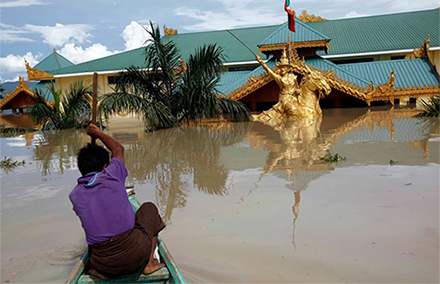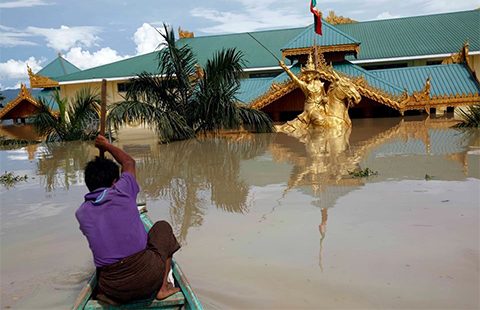
Flooded Kalay in Sagaing Region at its worst. Photo by BBC Burmese.
Floods raise questions about the nation’s ability to meet the threats of climate change and natural disaster.
Large areas of Myanmar have been devastated in recent weeks, with heavy monsoon rains triggering flash floods and landslides that have destroyed thousands of homes, roads, bridges and farmlands.
Twelve states and regions of the country’s 14 are severely affected, leaving at least 69 causalities and thousands of people stranded in the flooded areas.
Four states and regions have been declared disaster zones and the Myanmar government estimates that more than 200,000 people are in need of lifesaving assistance, making it the largest natural disaster since Cyclone Nargis in 2008, which killed more than 100,000 people and affected as many as 2.4 million.
The Myanmar government is responding to the event with some outside assistance, but it lacks the capacity to deal with a catastrophe of this scale, as many of the worst affected communities are still cut off by the flooding and landslides.
Once the immediate impacts are accounted for, the people of Myanmar will once again face the daunting task of rebuilding, with the livelihoods of thousands of families from some of the poorest regions in the country likely to be affected by the large-scale destruction.
Deforestation, unstainable land-use practices, damming projects and lack of policy initiatives for disaster risk management have compounded the effects of these latest torrential rains.
With an annual deforestation rate of 1.4 per cent, Myanmar has lost an average of 466,000 hectares of forest annually between 1990 and 2005, meaning 18 per cent of total forest cover has disappeared during that period.
Land-use changes have led to dramatic deforestation in much of Myanmar, causing large-scale soil erosion that has cut ground water carrying capacity and left millions further exposed to landslides and floods. Barren lands are prone to land slides, and flash floods are highly likely with no tree cover to hold water and prevent surface runoffs.
Damming rivers and streams and blocking natural water ways contributed to unlikely floods in some parts of the country. This has worsened because of a lack of well-planned risk management strategies.
These practices, added to the effects of climate change, will continue to leave millions of our countrymen and women vulnerable to the impacts of future natural disasters.
Since Nargis, cyclones are more frequent in Myanmar, with the country experiencing Cyclone Giri in 2010, Cyclone Mahasan last year and Cyclone Komen now passing through and causing torrential rains. It is also evident that monsoon patterns are also changing, with the effect that monsoonal rain now occurs later and ends earlier.
Myanmar is also one of the countries most vulnerable to climate change with its environmental degradation and unsustainable livelihoods practices. Policy initiatives and actions are urgently required to mitigate future impacts of climate change and to reduce the vulnerability of communities to climate change impacts.
We need to learn from the past to help reduce the risks in the future.
Ko Aye Chan Maung, is a master’s student from Myanmar studying at the Australian National University’s Crawford School of Public Policy, and a member of the ANU Myanmar Students’ Association (ANUMSA).
ANUMSA is raising money for Myanmar’s rescue and rehabilitation efforts. As part of these efforts it is hosting an event at ANU on Monday, 10 August. For more details on how to donate see here. Details of the event are here.
 Facebook
Facebook  Twitter
Twitter  Soundcloud
Soundcloud  Youtube
Youtube  Rss
Rss 